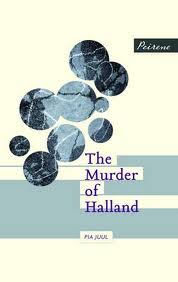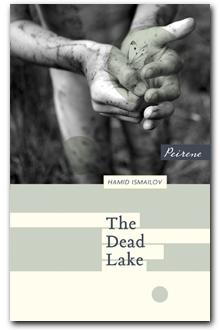‘The Murder of Halland’ by Pia Juul (translated by Martin Aitken)
-Reviewed by Nick Sweeney–
The Murder of Halland is presented as literary fiction author Pia Juul’s excursion into the crime novel, but you don’t get very far in before realising that it doesn’t fit into any genre. The first question that comes to mind is whether readers are happy with books like this: fans of crime fiction expect certain conventions in order to be comfortable with what they are reading, so I think it’s safe to say that this book may not appeal to them. However, there is much to admire here: lyrical and expert storytelling, a wealth of observations and some short, to-the-point humour, as in this exchange:
‘Where did you get that tan?’ I called after him.
Turning, he shrugged and pointed up at the sun.
One morning fiction author Bess’s partner Halland is shot dead with a hunting rifle. Juul goes with the convention that the first suspect is the closest relative by showing the local caretaker’s bumbling attempt to make a citizen’s arrest. This opening scene is a comic tour-de-force that paves the way for other encounters in the story.
There is enough in the setting to make fans of Scandinavian crime fiction feel at home. We see an unremarkable town, a nearby coastal area, taciturn characters who come to life in varying degrees of comic or sinister absurdity. There’s also an engaging protagonist caught up in events and knocked out of kilter in her attempts to regain control of her life in the face of bereavement, suspicion and puzzlement at the various mysteries that pile up after Halland’s death.
There are red herrings galore in the form of hints at Halland’s other life, his missing laptop, a secret room, and a possible heir on the way via his own niece, Pernille. The philosophy stops short of heavy-duty, never becoming ponderous. It’s a playful take on the crime novel, but no less satisfying for that. When it strays near the farcical, it is generally done in a skilful and pleasing way.
There are a few too many references to crime stories and the detective story parallels are taken a little too far when Bess dissects TV crime series at length. This was the one instance when I felt that the author was playing with us a little too roughly.
Unlike genre detective stories, the investigation into Halland’s death proceeds off the page. Even Bess professes not to be very interested in it. This may be an indication of Scandinavian detachment, that of people on the edge of the continent; it’s not fatalistic, nor even pessimistic, just pragmatic. The murder is soon sidelined by Bess’s relationships with her mother – also rather detached – her tetchy dying grandfather, her gloomy ex-husband and his controlling wife and, most importantly, with her estranged daughter. These relationships are picked up and added to gradually, until we get a clearer picture of Bess’s life and her approach to it. They show that Bess is not going to dwell on Halland’s death, not out of callousness, but from sheer pragmatism. Even before he is buried – in a chaotically impromptu funeral reduced to a lip-service ritual – she is determined to move on, unwilling to be distracted from her ongoing relationships by one that is over. Bess’s revelations about her life with Halland show more detachment, a connection between people content with their own interests.

Publishers Peirene Press urge readers not to skip the quotes at the beginning of each chapter – from works by Scandinavian authors, as well as Raymond Chandler, John Mortimer, Agatha Christie among others – but I didn’t find them very informative. More telling is an exchange running throughout parts of the book focusing on Eugene Ionesco’s The Bald Soprano (1950), generally acknowledged to be the first absurdist play: a friendly warning not to take everything in the story too seriously. There are also references to the well-known tale of impersonator Arnaud du Tilh – usually known as the ‘Martin Guerre’ story – that alerts readers to the possibility of deception in Bess’s first-person narrative. She is a potentially unreliable narrator who is also a fiction writer. She admits at one point that there is much she has left out, but doesn’t reward the reader with saying what that is – or what the point of that would be. When mulling over Pernille’s pregnancy, for example, Bess thinks:
‘Was I meant to ask if Halland was the father of Pernille’s child? I wouldn’t. How could Halland have fathered a child? That made no sense. Then why did I assume the baby was his? I had no reason. With whom was I angry?’
Bess doesn’t pursue this line any further. There is much that goes unexplained in the story, some of it quite self-consciously: ‘Brandt’s lodger. I haven’t described him. I won’t bother now; it’s irrelevant.’ Some of these unexplained events, such as Bess’s occasional flirting with the comic caretaker, or her sudden abandonment – with her fee in her bag – of a reading she has been scheduled to give, and her curiosity about her doctor neighbour’s visitor are like marked paths that are never followed, leaving the reader wondering, but at the same time left with enough to ponder as the narrative races on. They again betray the detachment in Bess’s character: the wish to mention but then dismiss, rather than process. I thought the disappearance of Brandt, the doctor, needed more explanation, from the author as well as from her mouthpiece, Bess. Was it put in just to tease the reader with a suggestion of his guilt, or to add to the atmosphere of menace created by the murder? It’s not too important: once you’re this far into the story you’ll go along with every unreliable word and enjoy the whole for what it is, a well-told take on bereavement, detachment, and a refusal to be shackled by conventions.




Pingback: My Homepage
Pingback: hcg